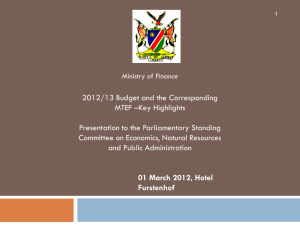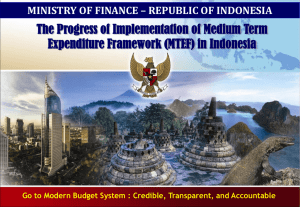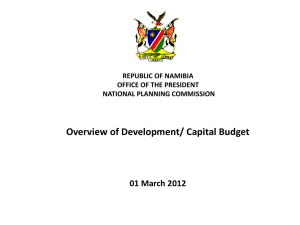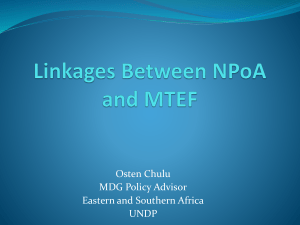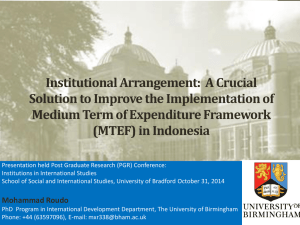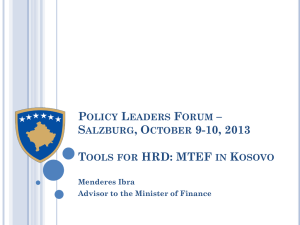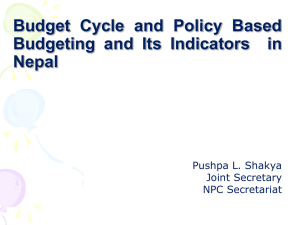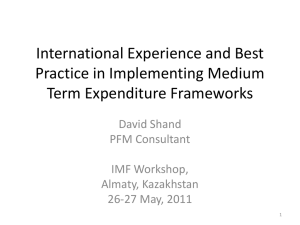Sector Investment Plan
advertisement
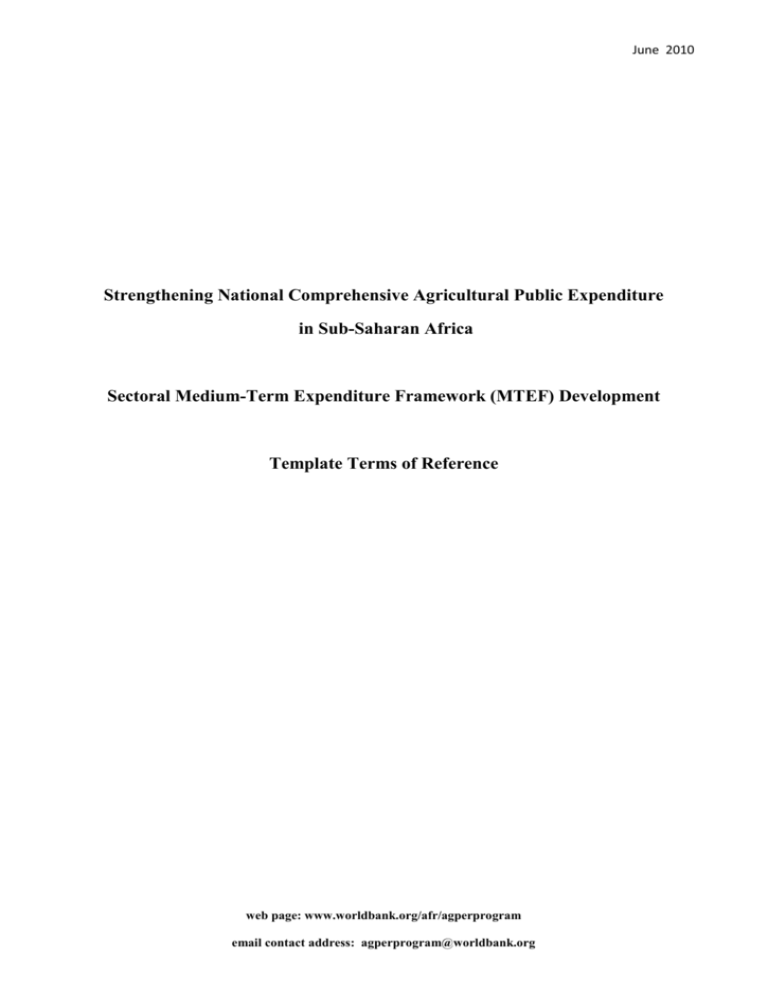
June 2010 Strengthening National Comprehensive Agricultural Public Expenditure in Sub-Saharan Africa Sectoral Medium-Term Expenditure Framework (MTEF) Development Template Terms of Reference web page: www.worldbank.org/afr/agperprogram email contact address: agperprogram@worldbank.org 1. Background The programme “Strengthening National Comprehensive Agricultural Public Expenditure in Sub-Saharan Africa” financed by the Bill and Melinda Gates Foundation and implemented by The World Bank, seeks to improve the impact of scarce public resources spent by Sub-Saharan African governments on agricultural sector development activities, thereby improving the welfare of predominantly poor rural populations. It operates in the context of the Comprehensive Africa Agriculture Development Programme (CAADP) of the African Union’s (AU) New Partnership for Africa’s Development (NEPAD) which encourages governments and development partners (DPs) to target public expenditure on the agriculture sector as the most effective way of stimulating growth in the sector, thereby reducing hunger and poverty. The overall objective of the programme is, through providing analytical support, to promote the articulation and implementation of strengthened national comprehensive agricultural public expenditure programmes so as to build consensus for increased levels of public expenditure in the sector in SubSaharan Africa, and to enhance its efficiency, effectiveness and equity. The programme is intended to provide evidence-based recommendations that will address, inter alia, budgetary planning, budget execution, and accountability in the agriculture sector, the creation of a reliable data base, and more effective intra- and inter-sectoral coordination. It is also aimed at stimulating larger donor resource allocations, and enhanced harmonization and alignment of resources behind national strategies. In the specific context of CAADP, the programme will focus on: the level of expenditure on agriculture, with particular reference to the explicit target by African Heads of State in the Maputo Declaration to allocate 10% of national budgets to the sector; the composition and priorities of expenditure with respect to stated national strategies, evidence of impact, sustainability and absorptive capacity; and, budget planning and implementation so as to strengthen public financial management in general and in particular budget coherence, outputs, outcomes and supporting mechanisms such as procurement and audit. Template Terms of Reference Two different levels of analytical support will be provided through the programme: (a) to conduct a basic agriculture sector public expenditure review (PER) in countries where this work has not already been undertaken recently, and (b) to carry out specialised public expenditure analyses in situations where an agriculture sector PER already exists. The three specialised studies are: the development of a sectoral medium term expenditure framework (MTEF) (the subject of these terms of reference); public expenditure tracking surveys (PETS); and, expenditure component impact evaluation. The existence of an agriculture sector PER is the prerequisite for conducting the other specialised studies. This should provide the essential understanding of the structure of public support for the sector and of the flows of funds that result. The public expenditure tracking survey (PETS) which examines outputs of public programmes, and the expenditure component impact evaluation study which looks at outcomes, are both backward looking exercises designed to inform policy and programme design. They both feed into sector investment programmes as part of the sector MTEF which is forward looking. The output of the analytical support will be country-specific reports that have been prepared jointly by government staff from the Ministries of Agriculture and of Finance together with external technical assistance. The purpose of preparing template terms of reference (TOR) is to provide a clear framework which defines the scope, methodology and processes that should be adopted when carrying out each country study, Page | 2 whilst allowing flexibility for the task to be tailored to the specific needs, data availability and analytical capacities that exist in each country. The terms of reference are for the whole task and not solely for the technical assistance team that will be engaged on this work. They should serve as a checklist of items that should be covered in each study together with an indication of the level of detail that should be attempted and possible data sources and approach [shown in parenthesis in the methodology section below]. The template framework aims to ensure that, as far as possible, data and analyses can be compared across different countries. The template TORs for developing a sector MTEF draw for their methodology upon the “Practitioners’ Toolkit for Agriculture Public Expenditure Analysis” (APEA) put together by World Bank and DFID1, the Bank’s “Public Expenditure Management Handbook”2 and the guidance note on “Linking the PRS with National Budgets”3. 2. Scope The purpose of this specialised study is to assist selected governments in sub-Saharan Africa to strengthen their agriculture sector programming and budgeting and the effectiveness of their public expenditure in the sector through formulating an agriculture sector MTEF. A MTEF has three main elements: (a) projections of the aggregate resource envelope or budget ceilings for the medium term provided from the MoF; (b) bottom-up cost estimates of the sector programme; and, (c) a political and administrative process that integrates and reconciles the two. The decision by government to formulate a sectoral MTEF is part of a shift in planning and budget processes towards a medium-term budget perspective within a macroeconomic framework which projects the resources available to the public sector. It also implies the adoption of a planning mechanism which comprises the allocation of budget ceilings to each sector, the formulation of sound sector investment plans, a process to monitor programme effectiveness and, in its most comprehensive form includes a shift to performance-based budgets. It is important that the MTEF exercise is fully integrated into the budget process. Budgets to Include The MTEF should represent consolidated government expenditure in the sector, including both capital and recurrent budgets. For this reason, it is important that the task of formulating a sector MTEF is preceded by an agriculture sector PER which, as far as possible identifies and evaluates all capital and recurrent expenditures and ensures that the development budget incorporates all public expenditures in the sector, including all those financed externally by donors (that is, include all items on budget regardless of source of financing). Country Selection In order to serve a constructive purpose, it is important to choose carefully the countries that will be selected for support. A sector MTEF is a comparatively sophisticated planning and budgeting mechanism, but it is in effect, just one part of a broader set of reforms in public financial management (PFM) or public 1 “Practitioners’ Toolkit for Agriculture Public Expenditure Analysis”, World Bank and DFID (draft) “Public Expenditure Management Handbook”, World Bank, 1998 3 “Linking the PRS with National Budgets: A Guidance Note”, PREM Poverty Reduction Group, September 2008 2 Page | 3 expenditure management (PEM) and cannot alone deliver the desired improvements in expenditure management when other key elements are not in place4. The criteria to apply when making a selection should be countries: In which the MoF has provided the necessary overall framework for the exercise In which country circumstances are appropriate for an MTEF to be an element of the PFM system5, that have already initiated the process of establishing a medium-term planning and budget system (often with technical support from the World Bank) and agriculture is included as one of the sectors, even if on a pilot basis for initial implementation, because of its scale and importance in overall public expenditure. In which an economy-wide public expenditure review (PER) has been conducted recently together with a PER for the agriculture sector. In some cases, the basis for developing a sectoral MTEF will be the Basic AgPER which has been carried out as part of this overall programme. That have other critical elements of PEM in place In which the MoA has actively engaged with DPs with a view to moving towards programme lending in some form That have, at least in draft form, a sound sector investment plan Sector Investment Plan A vital element of a sector MTEF is a sound, multi-year sector investment plan. Although most African countries have formulated sector strategies for agriculture, few have taken the next step of translating this into a medium- or long-term public investment plan. The CAADP Country Roundtable process, which has been completed in some 15 countries6, culminates in the signing of a compact by all national stakeholders and the development partners in support of an agriculture sector strategy. CAADP is in the process of designing a strategy for the post-compact stage7 which will focus on assisting governments to translate their sector strategies into medium-term investment plans. The specialised MTEF work envisaged under these TOR will be undertaken in countries which have progressed sufficiently with the CAADP post-compact stage activities to have formulated a sound sector investment plan. The TA team, TWG and the SWG will initially review the sector investment plan, buts its focus will be to assist government to take the next step towards establishing an agriculture sector MTEF. Institutional Scope The institutional scope of agriculture, as defined by the classification of the functions of government (COFOG) system (see Appendix I), may include not just the Ministry of Agriculture but also related ministries if, for example, forestry, fisheries or livestock are in one or more separate ministries, as well as related agencies. An agriculture sector strategy and its associated investment plan will normally embrace all sector-related institutions. However, as a process that is essentially driven by the budget formulation process, a sector MTEF will often be much narrower in scope and only include those investment plans that 4 Le Houerou and Taliercio, “Medium Term Expenditure Frameworks - From Concept to Practice: Preliminary Lessons from Africa”, World Bank Africa region Working Paper Series No. 28, February 2002 5 A “Review of Experience with Medium-Term Expenditure Frameworks (MTEFs)” is currently being undertaken by PRMPS and it is envisaged that the review will provide guidance on country circumstances where an MTEF is appropriate. 6 By March 2010 a total of 15 countries had signed compacts: Benin, Burundi, Cap Verde, Ethiopia, Gambia, Ghana, Liberia, Mali, Niger, Nigeria, Senegal, Sierra Leone, Swaziland, Rwanda, Togo 7 NEPAD/CAADP “Post Compact Review: Guidelines” (draft) Page | 4 concern the main sector line ministry. In most cases, the main line ministry is the Ministry of Agriculture. However, in countries where agriculture sector activities are subsumed under a Ministry of Rural Development which has a broader mandate, support will be provided to strengthen the planning and budgeting processes for the entire ministry. In view of the lead role that it plays in macroeconomic planning and budgeting, the Ministry of Finance (and Planning) will be a key collaborator in the task. Implementation This specialised study would provide hands-on support of a technical assistance (TA) team to Ministry of Agriculture planning and budgeting staff (constituted as a technical working group (TWG)) who are engaged in formulating a sector MTEF. A sector working group (SWG) comprising sector specialists, staff responsible for the sector within the MoF, representatives of CSOs and the private sector and a representative from the DWG, would provide oversight of the exercise and links to high level decision-makers. The exercise should be timed so as to synchronise with the regular budget cycle. In view of the amount of additional work required and the need for broad consultation, one full year of preparation is likely to be needed. The programme will be carried out by a TA team comprising one international expert with the necessary analytical skills, and two national experts with knowledge of the sector and evaluation methodology working closely with government counterparts. The national expert will bring country and sector knowledge as well as analytical skills and will share responsibility with the international expert for evaluation survey design, data gathering, analysis and report writing. Unlike the other specialised studies under this public expenditure programme, the role of the TA team will be to support with technical advice and expertise what is essentially a government-led process. The specific outputs of the TA team are listed in section 6 below. Donor Working Group (DWG) The active engagement of the DWG in the MTEF process is important for several reasons: To ensure that a realistic level of external resource availability based on DP commitments in CAADP compacts are integrated To facilitate the emergence of a SWAp or programme-based approach (PBA) in the sector that will help to harmonize donor assistance to the sector To identify potential barriers to moving towards “basket funding” for the sector To provide an agenda for continued discussion with government on budget issues such as procurement procedures and financial management in general 3. Methodology There are six main steps involved in formulating a sector MTEF8: 1. Development of a macroeconomic/fiscal framework 2. Development of sector programme 8 See the “Public Expenditure Management Handbook” Page | 5 3. 4. 5. 6. Development of sector expenditure framework Definition of sector resource allocation Preparation of sector budget Final political approval The first [Development of a macroeconomic/fiscal framework], fourth [Definition of sector resource allocation] and last [Final political approval] stages are outside the mandate of the sector line ministry and are respectively in the remit of the Ministry of Finance (and Planning) and Cabinet and/or Parliament. The overall fiscal framework set out by the MoF estimates of the revenues and expenditures in the public sector in the medium term (3-5 years). The allocation to the different sectors of medium-term expenditure ceilings is a process in which different sectors negotiate shares and the MoF assesses sectoral trade-offs, but is ultimately a political decision. The final, political stage of the process is the approval of the budget estimates for the current year and the rolling programme as a whole by the Cabinet and Parliament. 1. Development of an Agriculture Sector Programme The formulation of a medium-term sector investment plan (or programme) is a crucial element in operationalising a sector MTEF. Unlike health and education where outputs and outcomes can be readily conceived, a sector investment plan for agriculture requires a complex set of choices between sub-sectors and types of goods and services to be delivered. Sector investment plan: The TA team will review the adequacy of either existing investment plans or a plan that has emerged from the CAADP post-compact process, focusing on those portions under the main agriculture ministry which is being supported to engage in the MTEF. In countries where the CAADP Country Roundtable has reached the compact stage or is under way and external TA support is being provided under the CAADP Post-Compact programme to facilitate the finalisation of a sector investment plan, work under this TOR will await the finalisation of the post-compact activity. The criteria that might be applied by the TA team to reviewing the soundness of the plan are presented in Appendix II. The most important elements of such a plan are that it should be: Consistent with the sector strategy [this could be either an existing sector strategy document or one that has been put together in the context of the CAADP Country Roundtable process] Aligned with the national PRS goals, in particular with respect to food security [PRS document; poverty action plan etc] Evidence-based, built upon evaluations of the performance of different sub-sectors and services [CAADP “Stocktaking and Institutional Analysis” where a country has completed its CAADP process; otherwise, based upon sub-sector evaluations, M&E] Prepared following broad stakeholder consultation including farmer representatives, civil society and the private sector [consultation should be verified in the case of a CAADP country; otherwise, consultation mechanism should be proposed] Prepared in close collaboration with development partners and based on realistic projections of external resource availability [ensure full engagement of the DWG in the preparation through representation on the SWG] Prepared with an explicit financing role for the private sector, built upon its involvement in the planning process [private sector involvement formalised in the planning process through Chambers Page | 6 of Commerce and major sector traders, processors, input suppliers and other players in the main domestic and export value chains] Fully costed [detailed costs required for the 1st year; broader cost estimates for subsequent years] Indicative financing: At this stage it is important for senior sector management to decide on the scale and modality for financing the plan. A preliminary and broad indication of the “fiscal space” available to the sector must be sought from the MoF at the earliest opportunity. This will avoid the risk of seriously overdimensioning the plan, which would make it difficult to reconcile proposals with the final budget envelope. It must also be decided whether to propose moving towards a sector-wide approach (SWAp), a programme-based approach (PBA) or following a more traditional mix of projects and programmes. Sector programme costing: One of the most important tasks confronting the TA team will be to assess the extent to which the costing of the investment plan is realistic. This will involve: Examination of cost consistency across sub-programmes Adequacy of standard costs applied Incorporation of reasonable physical and price contingencies Role of donors: Especially in the context of CAADP Country Roundtable processes, close collaboration with development partners is crucial in the formulation of the sector investment plan. The DWG should be engaged in the process from the beginning, facilitated by the TA team. The sector investment plan should build upon commitments made by DPs when signing the CAADP country compact and should aim to enhance the harmonization of donor assistance to the sector, ideally through the formulation of a SWAp. Decentralised units: In countries where there is substantial fiscal decentralisation, the process of formulating a sector investment plan can be protracted. Indeed, in some countries there might be inadequate capacity at the decentralised levels to formulate a sector investment plan in detail. In this case, the exercise will need judge whether to utilise sub-national programmes that have been inadequately formulated, or to accept that the MTEF will be only partial. In either case, the overall MTEF planning process will need to allow time for decentralised units to: Be briefed on the MTEF process Be trained on the use of guidelines on the formulation of sub-national sector investment plan Finalise their own draft investment plans for incorporation into the sectoral plan. 2. Development of an Agriculture Sector Expenditure Framework The purpose of adopting a MTEF approach to planning and budgeting is to strengthen the link between policy and budget, and to introduce a “results” orientation in the way resources are allocated. Whilst African governments and donors have committed themselves to substantially increasing the resources allocated to agriculture, proposals for scaling up public expenditures have to be based upon an assessment of performance by the main service deliverers, and sound investment proposals. Unless directed otherwise by MoF, the sector MTEF should be prepared for a three-year period. Although sector investment proposals may be prepared for five or more years, the incorporation of five-year cost estimates into the sector MTEF is likely to reduce its credibility. Page | 7 The sector expenditure framework is the consolidation of all projected public expenditures in the sector on the basis of investment plan proposals for new programmes, together with on-going programmes and recurrent commitments. Sector options: As the sector investment plan is being formulated, decisions about choices or trade-offs between different investments will have to be made. The study will assist in the identification of options and trade-offs by: Using available sectoral CGE or other econometric modelling, identifying the main sources of growth in the sector, trade-offs between different sub-sectors, inter-linkages between agriculture and the rest of the economy, and the effects of alternatives upon households [conclusions from computable general equilibrium (CGE) modelling exercise where a country has completed its CAADP process] Taking lessons from the sector PER, from public expenditure tracking studies (PETS) and from impact evaluations, in order to evaluate: Capital (development) budget, identifying the main projects, programmes and areas of expenditure and assessing their effectiveness, impact and alternative approaches or forms of delivery Recurrent (revenue) budget, including its composition, in particular wage vs non-wage expenditures in order to assess where the recurrent budget is being inefficiently used or where the potential impact of capital investments is being limited by inadequate recurrent budget provision Individual sub-programmes and expenditures, especially scrutinising areas where private goods are being delivered with public resources and whether this can be justified Reviewing programmes and projections of expenditures at lower administrative levels At this stage, MoA should be in a position to present a series of options for the main programmes and expenditure items, which have been broadly costed. 3. Preparation of an Agriculture Sector Budget When the sector investment plan and expenditure framework are completed, MoF should be ready to finalise its sectoral budget ceilings. A discussion would then be held with MoF on the identified “financing gap” between projected agriculture sector expenditure and the MTEF budget ceilings issued by MoF. At this stage it would be important for the TA team and DWG to brief the MoA and MoF on the main new sources of financing available under the Global Agriculture and Food Security Programme (GAFSP) and other funds. The TA team would assist the MoA planning and programming unit in reconciling the sector investment components with the announced budget ceiling. This process would be likely to include budget hearings at which spending plans are scrutinised and broad agreement reached on priorities. A key role for the TA team would be to facilitate the reaching of consensus on priorities. The output of this process would be: Estimated budgets for a set of capital investment projects or programmes (or SWAp) for a 3-5 year period Estimated budgets for modified on-going development projects and programmes Estimates of existing and future recurrent budget commitments Page | 8 The sector budget would contain full details for central and (where appropriate) decentralised units for the current (1st) year, with broader projections on development and recurrent budget for the 2nd and subsequent years. Recommendations This will be primarily a “hands on” exercise, shepherding a MoA team over the course of a year in formulating a sector MTEF. It is likely that, as part of the learning process there will be lessons to be learnt and areas in which the second iteration of the process could be improved. Although many of the steps in the process will apply beyond the agriculture sector, the TA team will put together a set of recommendations that might include: The inclusion of a “strategic phase” early in the budget planning cycle at which the sector line ministries are able to discuss with MoF the past performance of the sector, outline spending plans and draw attention to the programme links with national policies and priorities. The MoF would, in turn, announce provisional budget ceilings as a guide for the formulation of the investment plan. Streamlining the process of assembling programmes from decentralised units for inclusion in the overall sector MTEF Proposals to enhance the soundness of the resource projections made by MoF, including ways of improving the methodology upon which they are made (CGE, spreadsheet or IMF programming). Measures to enhance PFM in the sector, in particular central and/or decentralised unit accounting, auditing and procurement procedures, which would build confidence on the part of DPs in the ability of the sector to utilise additional resources effectively and accountably Measures to fully integrate the MTEF into the budget process and secure high level political engagement in the approval process Enhanced oversight mechanisms and inclusion of performance indicators and targets 4. Sources of Data and Information In view of time and resource constraints, official published budget-related documents will form the primary source of data and little or no generation of original data from studies will be possible. Wherever possible, existing special studies on the sector as well as unpublished material should be used to add depth and documentation to the formal data collected. Where such sources are used, they should be validated and fully referenced. Focus group discussions in the key ministries (MoA, MoF) will be an invaluable source of information when formulating a sound descriptive overview of the public expenditure budget in the agriculture sector. Official sources: Published budget estimates Published reports on budget outturn Published agriculture sector strategy and investment plan Electronic data from MoA and MoF Published reports and statistics from MoA and associated agencies such as the Ministry of Trade and/or Commerce Page | 9 Studies and “Grey” sources: Donor reports and interviews on “off-budget” expenditures Sub-sector project appraisal documents for more detailed information on focus areas and expenditures Special surveys or evaluation reports CAADP Country Roundtable reports Sector project evaluations (ICRs) or mid-term reviews Sources for reviewing sector outputs and outcomes: MoA studies and reports Project appraisal documents, mid-term reviews, ICRs Focus group discussions with project managers and teams Donor evaluation reports Beneficiary impact assessments 5. Process The countries in which assistance will be provided to develop an agriculture sector MTEF will have responded positively to an invitation to be part of the continent-wide exercise. They will also have satisfied the basic selection criteria of having a sound PEM framework, have or be in the process of setting up an overall MTEF, and have conducted an agriculture sector PER within the previous two years. A fully participatory approach is to be adopted for the task. The most important first step in starting the exercise is to establish a good working partnership with the key stakeholders: MoA, MoF, the donor working group (DWG) for agriculture, CAADP Focal Point, parliamentarians, representatives of the private sector, and CSOs. As part of the process of moving towards a MTEF, the MoF would usually have required the sector line ministry concerned (in this case the Ministry of Agriculture) to set up a technical working group (TWG) responsible for undertaking the necessary work. This TWG would be the principal technical level counterpart for the TA team. The TA team would work closely with the TWG, propose a “roadmap” for completing the task over a period of one year and suggest technical working papers that might be produced to further dialogue on the work and raise issues that need to be addressed. The TA team would also collaborate with MoF which would assign one or more technical counterparts for the period. The main stages in the study process will include: Stakeholder briefing: All key stakeholders9 must be briefed on the purpose and proposed outputs of the exercise and agree on the main milestones and the timeline. Agreement should also be reached upon the ministry or ministries to be included in the study and whether decentralised units should be covered. 9 The CAADP Country Roundtable consultative process provides a possible scope for relevant stakeholder consultations. Page | 10 Inception workshop: A formal workshop for all key stakeholders should be scheduled within two weeks of the commencement of the study to present and discuss an Inception Report that includes: The revised terms of reference for the study Queries and outstanding issues with respect to the study Agreed milestones and timeline for implementation Designation of counterpart staff Definition of the institutional scope for the study The workshop should solicit the support of government officials in facilitating access to published and electronic expenditure data, and from DPs (through the DWG). Sector working group: An agriculture sector working group (SWG) should be set up to oversee the exercise. It should comprise sector specialists within agriculture, senior staff responsible for the sector within the MoF, representatives of CSOs and the private sector and a representative from the DWG. The SWG would: Receive, review and comment upon technical working papers prepared by the TWG in the MoA Review the sector investment plan Review the sector expenditure framework Review the sector budget ceiling and engage in discussions with MoF on the allocations Review the draft sector budget and its consistency with the sector MTEF Engage with Parliamentarians on presentation of the sector budget and approval of the MTEF Technical workshop: Within one month, a technical workshop comprising the TWG in MoA and MoF should be scheduled to: Present a progress report on setting up the SWG and defining its tasks Discuss and schedule the technical working papers that should be prepared by the TWG Draft report workshop: A formal workshop should be scheduled after five months to discuss the key conclusions and recommendations of the study presented in a draft report. Managing change: A crucial element for the TA team in supporting the formulation of a sector MTEF, including the preparation or review of a sector plan, will be to manage the expectations and unrealistic budget requests from different sub-sectors or service delivery units. This will include managing the transition from earlier programmes and budget processes into the new MTEF process. Ideally, the MTEF should be fully integrated into the budget process, but this might not always be feasible. The main issues to address include: Critical review of on-going development projects and programmes to assess their alignment with national and sectoral policies and priorities and their effectiveness Review of existing recurrent budget commitments and their incorporation into the sector budget Identifying and adjusting “traditional” budget processes (such as: “request twice the budget you really need”) Page | 11 6. TA Team Outputs, Reports and Database TA Team Outputs The TA team, in close collaboration with the TWG in MoA and MoF, will be responsible for the following tasks: Helping to launch the sector MTEF process Advising on setting up the SWG, including its composition Drawing up the terms of reference of the SWG Defining the institutional scope of the MTEF Commissioning technical working papers from the TWG and reviewing them Evaluating the basis for costings including the use of standard unit cost and consistency of application Reviewing the sector investment plan Identifying capacity building needs Facilitating the process of reconciling the sector expenditure framework with finally announced medium-term budget envelope Assisting in preparing briefs for budget hearings Liaising with the DWG Formulating recommendations for enhancing the MTEF process Reports Following consultation with all the main stakeholders, the TA team will prepare the following reports: Inception report: within two weeks, which presents the revised terms of reference for the study, raises issues and defines the institutional scope of the study Draft report: at least one month before conclusion of the exercise (say in month 10 or 11), which presents a review of the technical working papers, describes the strengths and weaknesses of the MTEF processes and presents recommendations Final report: within 12 months, incorporating the comments and discussion of the draft report Database During the assignment, the TA team in collaboration with MoA and MoF will establish a database including background documents and sources, evaluation methodology, data sampling frame and questionnaires, survey data, analytical working papers and analyses that can be put online. This database will be used for capacity building purposes as part of a joint learning activity under the overall public expenditure programme. 7. Timeline The overall timeline for the agriculture sector MTEF is one year (see Fig. 1). Page | 12 8. Resources The agriculture sector MTEF development exercise will be conducted by a consultant team comprising one senior international expert with methodological expertise and cross-country experience, plus one national expert. Both experts will devote 12 weeks of work to the exercise within the overall time frame of one year. The international expert will be consulted in the selection of the national expert. The Ministries of Agriculture and of Finance will be requested to provide at least one full-time counterpart or team equivalent for each consultant. Think tanks, universities and other local contributors to the exercise will not be remunerated. Page | 13 June 2010 Annexe – Timeframe
